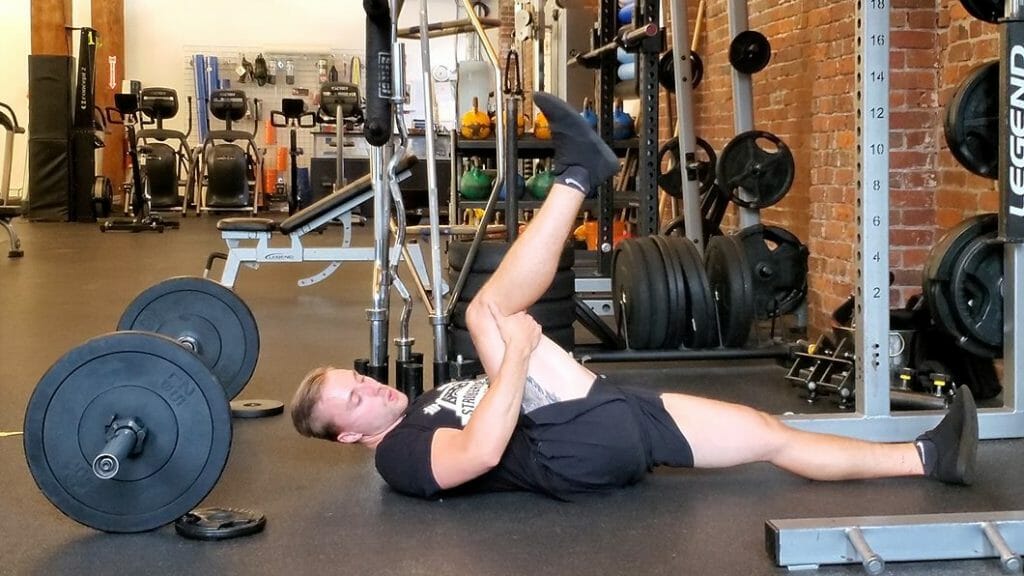Continuing with our Tech Corner Series so far, we will be covering the key coaching ideas in the conventional deadlift. If you haven’t already seen our Bench Press or Squat editions, click on the hyperlinks to check ’em out!
The 3 main points we cover with the powerlifting deadlift are: ensuring adequate hip mobility, proper spinal awareness and control, and keeping a mid-foot centered deadlift.
1) Hip Mobility
Without enough movement at the hips, it doesn’t matter how strong your brace is, you WILL round your back to get the bar to the floor using standard diameter plates. As a powerlifter with an average build, you should be able to flex the hips to around 135 degrees, with a bent knee. We can further divide this mobility into two categories:
a. Passive: the ability to bring a bent leg to the appropriate amount of hip flexion while on the back. If the lifter can do this but not deadlift with a flat back, it’s an awareness and control issue (Active Mobility).
b. Active: With the lifter holding a dowel, they need to be able to perform a deadlift with a dowel or broomstick (closed chain hip hinge) without losing lumbar position or intra abdominal pressure. This is often a lumbar spine and pelvis stability exercise that many lifters can’t perform properly, but load up hard with a barbell anyways. This should be addressed with the points outlined below in the spinal awareness and control section.

2) Trunk Awareness and Control
Once we’ve established that the athlete does have enough movement potential (mobility) in the hips, we need to ensure that they can actually move at the appropriate joints (hips and knees, primarily), without excess movement at the spine.
The first step here is ensuring the athlete can feel if/when they make an error; you can’t fix what you can’t feel. Using tools such as a 360 belt is an excellent tool as you can still load the way you want to, but it allows for better sensation as to what the core musculature is doing. Perfect for learning how to properly stabilize the trunk.
Some more specific tools for deadlifts once basic awareness has been developed are the Tempo Deadlift and Forward Band Deadlift. Sometimes deadlifts vs pins are useful, but the athlete needs to be able to self-monitor and ensure they maintain proper IAP and spinal position in the movement.
3) Stacking Over The Mid-Foot
After building up a good movement base, the last main detail we tune into for an efficient deadlift is ensuring that the center of mass for the barbell (center of the bar cap) and the lifter’s body (mid-foot and scapula) are aligned over each other. This ensures that the lifter can apply force in an upwards direction (the most efficient path against gravity) instead of needing to make adjustments front-to-back or side-to-side in order to get the bar to go straight up, which results in wasted energy at best, and injury mechanisms at worst.
This position should be maintained through the lift, from the floor all the way to lockout. If a lifter is having issues with drifting forwards in the lift, adding a band pulling forwards on the bar (Forward Band Deadlift) can be a nudge in the right direction so that the athlete has to “pull back” more and re center themselves. Slowly transitioning away from the band is a great tactic to use when building technique in the deadlift.
Give these 3 points some attention in your deadlifts and they should pay big dividends in the long run for both injury prevention as well as improving efficiency and your max strength.
PS – Here’s 3 ways I can help you get stronger:
3. Apply to join my “Momentum Program” and become a case study. We’ll work with you 1-on-1 (in-person or online, depending on location) to consistently increase your PRs.
It takes less than 60 seconds to apply HERE in order to find out more information and see if you’d be a good fit.